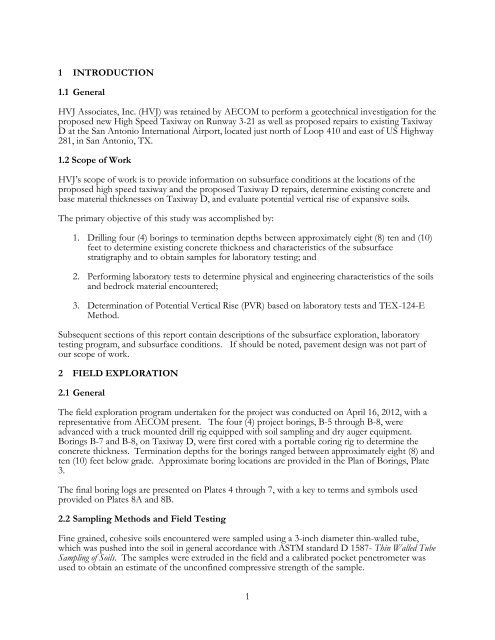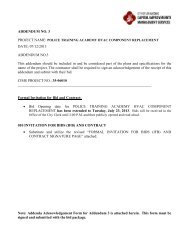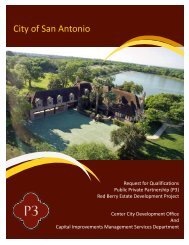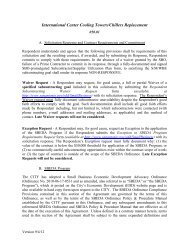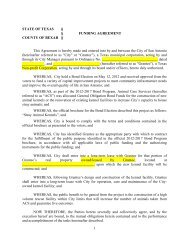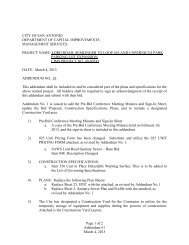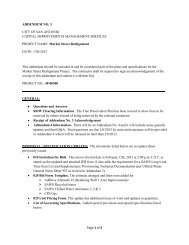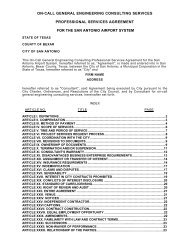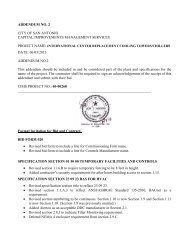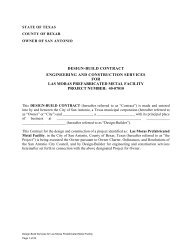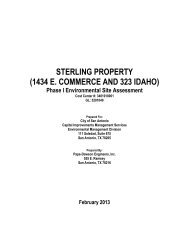Geotechnical Investigation Report - The City of San Antonio
Geotechnical Investigation Report - The City of San Antonio
Geotechnical Investigation Report - The City of San Antonio
- No tags were found...
You also want an ePaper? Increase the reach of your titles
YUMPU automatically turns print PDFs into web optimized ePapers that Google loves.
1 INTRODUCTION<br />
1.1 General<br />
HVJ Associates, Inc. (HVJ) was retained by AECOM to perform a geotechnical investigation for the<br />
proposed new High Speed Taxiway on Runway 3-21 as well as proposed repairs to existing Taxiway<br />
D at the <strong>San</strong> <strong>Antonio</strong> International Airport, located just north <strong>of</strong> Loop 410 and east <strong>of</strong> US Highway<br />
281, in <strong>San</strong> <strong>Antonio</strong>, TX.<br />
1.2 Scope <strong>of</strong> Work<br />
HVJ’s scope <strong>of</strong> work is to provide information on subsurface conditions at the locations <strong>of</strong> the<br />
proposed high speed taxiway and the proposed Taxiway D repairs, determine existing concrete and<br />
base material thicknesses on Taxiway D, and evaluate potential vertical rise <strong>of</strong> expansive soils.<br />
<strong>The</strong> primary objective <strong>of</strong> this study was accomplished by:<br />
1. Drilling four (4) borings to termination depths between approximately eight (8) ten and (10)<br />
feet to determine existing concrete thickness and characteristics <strong>of</strong> the subsurface<br />
stratigraphy and to obtain samples for laboratory testing; and<br />
2. Performing laboratory tests to determine physical and engineering characteristics <strong>of</strong> the soils<br />
and bedrock material encountered;<br />
3. Determination <strong>of</strong> Potential Vertical Rise (PVR) based on laboratory tests and TEX-124-E<br />
Method.<br />
Subsequent sections <strong>of</strong> this report contain descriptions <strong>of</strong> the subsurface exploration, laboratory<br />
testing program, and subsurface conditions. If should be noted, pavement design was not part <strong>of</strong><br />
our scope <strong>of</strong> work.<br />
2 FIELD EXPLORATION<br />
2.1 General<br />
<strong>The</strong> field exploration program undertaken for the project was conducted on April 16, 2012, with a<br />
representative from AECOM present. <strong>The</strong> four (4) project borings, B-5 through B-8, were<br />
advanced with a truck mounted drill rig equipped with soil sampling and dry auger equipment.<br />
Borings B-7 and B-8, on Taxiway D, were first cored with a portable coring rig to determine the<br />
concrete thickness. Termination depths for the borings ranged between approximately eight (8) and<br />
ten (10) feet below grade. Approximate boring locations are provided in the Plan <strong>of</strong> Borings, Plate<br />
3.<br />
<strong>The</strong> final boring logs are presented on Plates 4 through 7, with a key to terms and symbols used<br />
provided on Plates 8A and 8B.<br />
2.2 Sampling Methods and Field Testing<br />
Fine grained, cohesive soils encountered were sampled using a 3-inch diameter thin-walled tube,<br />
which was pushed into the soil in general accordance with ASTM standard D 1587- Thin Walled Tube<br />
Sampling <strong>of</strong> Soils. <strong>The</strong> samples were extruded in the field and a calibrated pocket penetrometer was<br />
used to obtain an estimate <strong>of</strong> the unconfined compressive strength <strong>of</strong> the sample.<br />
1


